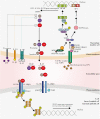Interleukin-23 in the Pathogenesis of Inflammatory Bowel Disease and Implications for Therapeutic Intervention
- PMID: 35553667
- PMCID: PMC9097674
- DOI: 10.1093/ecco-jcc/jjac034
Interleukin-23 in the Pathogenesis of Inflammatory Bowel Disease and Implications for Therapeutic Intervention
Abstract
The interleukin-23 [IL-23] cytokine, derived predominantly from macrophages and dendritic cells in response to microbial stimulation, has emerged as a critical promoter of chronic intestinal inflammation. Genome-wide association studies linking variants in IL23R to disease protection, bolstered by experimental evidence from colitis models, and the successful application of therapies against the IL-12/IL-23 shared p40 subunit in the treatment of inflammatory bowel disease [IBD] all provide compelling evidence of a crucial role for IL-23 in disease pathogenesis. Moreover, targeting the p19 subunit specific for IL-23 has shown considerable promise in recent phase 2 studies in IBD. The relative importance of the diverse immunological pathways downstream of IL-23 in propagating mucosal inflammation in the gut, however, remains contentious. Here we review current understanding of IL-23 biology and explore its pleiotropic effects on T cells, and innate lymphoid, myeloid and intestinal epithelial cells in the context of the pathogenesis of IBD. We furthermore discuss these pathways in the light of recent evidence from clinical trials and indicate emerging targets amenable to therapeutic intervention and translation into clinical practice.
Keywords: Crohn’s disease; Interleukin-23; ulcerative colitis.
© The Author(s) 2022. Published by Oxford University Press on behalf of European Crohn’s and Colitis Organisation.
Figures
References
-
- Uhlig HH, Powrie F. Translating immunology into therapeutic concepts for inflammatory bowel disease. Annu Rev Immunol 2018;36:755–81. - PubMed
-
- Hugot JP, Chamaillard M, Zouali H, et al. . Association of NOD2 leucine-rich repeat variants with susceptibility to Crohn’s disease. Nature 2001;411:599–603. - PubMed
-
- Ogura Y, Bonen DK, Inohara N, et al. . A frameshift mutation in NOD2 associated with susceptibility to Crohn’s disease. Nature 2001;411:603–6. - PubMed
-
- Hisamatsu T, Suzuki M, Reinecker HC, et al. . CARD15/NOD2 functions as an antibacterial factor in human intestinal epithelial cells. Gastroenterology 2003;124:993–1000. - PubMed
Publication types
MeSH terms
Substances
Grants and funding
LinkOut - more resources
Full Text Sources




